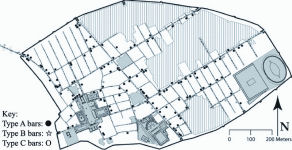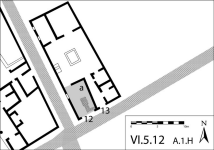
Figure 42: The distribution of bars at Pompeii.

Figure 42: The distribution of bars at Pompeii.
That such a high percentage of retail outlets with masonry counters focused their trade on food and drink points toward the importance of that trade in the Pompeian economy and community. If this were not already clear from the statistics of the typology alone, then it should certainly be so from their distribution across the Pompeian urban landscape. I have elsewhere (Ellis 2004) highlighted the role of the Pompeian food and drink outlet as demonstrated by their distribution in areas of greatest profitable gain - such as the main city gates, along the busier parts of main roads, opposite major public gathering places, and at the street intersections (Figure 42). Previous spatial studies of Pompeii have downgraded the role of such outlets in the community, preferring to measure their 'deviant' value through textual references from Roman elites, which they have presumed reflect the perspective, or sensitivities, of Pompeian elites (cf. especially, Laurence 1994, 70-87, and now revised Laurence 2007, 82-101), rather than through the very people for whom the bars actually operated on a daily basis. Further to my previous study, some additional observations on the distribution of particular types of bars throughout the city are worthwhile within the context of this article.
What typifies the distribution of Pompeii's food and drink outlets is their occurrence at intersections, the busiest confluence of any urban network. That 80, or 50% of all bars, were located at or in view of an intersection demonstrates the eagerness of retailers to ply their business with as many people as possible. Expressed in a different way, no fewer than 63 (or about two-thirds) of the 96 known intersections that connected the vast Pompeian street system were bordered by a bar. While this pattern might seem logical, given our own experiences in modern cities and towns, it contradicts recent efforts to characterise bars as socially unacceptable haunts, whose morally bankrupt activities were 'hidden from the view of women and children [who were to be] secluded from the realities of city life' (Laurence 1994, 87; and revised but upholding the same impression in Laurence 2007, 92, in spite of now countless arguments and examples to the contrary: for a recent example, McGinn 2002; see also Wallace-Hadrill 1995 on the distribution of the erroneously defined 'popinae'). The results from my survey illustrate this so-called 'moral zoning' to be a fantasy, conjured from the use of interpretation as 'legacy data', rather than through any engagement with the actual physical remains in Pompeii.
When we differentiate among the different types of bars found at intersections and along main roads, some interesting patterns arise. For example, the primary routes of Pompeii - which I have defined as those streets passing through one of the city gates and heading toward the civic forum (or linking with another primary route for the same destination) - were littered with food and drink outlets: no fewer than 95 (60% of the total) bars are counted along these roads. These percentages are consistently high across the three types of bars: 75 Type A bars (59% of the total of that type); 13 Type B bars (62% of the total of that type); and 7 Type C bars (78% of the total of that type). This overall count rises to 115 bars, or 73% of the total, if we include some other seemingly equally important roads to this list, such as the monumental Via di Mercurio/Via del Foro which passed through the so-called Arch of Tiberius to access the forum, as well as its southern extension from the forum at the Via delle Scuole, and the ring-road of Vico dei Soprastanti/Via degli Augustali/Vico del Lupanare/Via dei Teatri that bordered the so-called Altstadt at regio VII. The percentages for these types of bars, found both on the primary routes and these additional important routes, are curiously high: 91 Type A bars (71%); 16 Type B bars (76%); and 8 Type C bars (89%). This pattern among the types of bar is true for their location at intersections. Sixty-eight Type A bars (43% of that type) were located at an intersection, and nine Type B bars (remarkably the same ratio, with 43% of that type) were similarly located. The division of these into sub-types produces the same high percentages. However, because so few Type B properties exist, only Type A bars may be meaningfully analysed (Figure 43).
Figure 43: Distribution of Type A bars at Pompeian street intersections.
| Type | # at an intersection | % of that Type |
|---|---|---|
| A.1/A.1.H | 13 | 52% |
| A.2/A.2.H | 18 | 53% |
| A.3 | 11 | 48% |
| A.4 | 26 | 56% |
Among these Type A bars, the pattern breaks down most strikingly for the properties that were attached to a house at an intersection. Figure 43 demonstrates that just over 50% of each of the single- and double-room Type A properties were positioned at an intersection. But differentiating among the 52% of single- and 53% of double-room Type A bars at intersections, as illustrated in Figure 44, indicates that house-owners who lived at an intersection tended to take full advantage of their position, compared to those who owned space away from a street corner. For the few who had the choice of which of their front rooms would be converted to a bar, the clear majority chose the one closest to the intersection (e.g. VI.5.12 - Figure 45; and I.2.29; I.8.1; I.13.13; II.3.5; III.6.1; III.8.9; VI.15.15; VII.2.15; VII.3.23). Even those who were located further away from an intersection chose to locate their bar on the side of their property closest to that confluence (e.g. I.3.21-22; I.10.2-3; IX.11.2).
Figure 44: The percentages of 1- and 2-room type A bars that occur at intersections in Pompeii.
| Type | % of that type to occupy an intersection |
|---|---|
| A.1 | 43% |
| A.1.H | 64% |
| A.2 | 50% |
| A.2.H | 63% |

Figure 45: VI.5.12 at Pompeii. Note that the bar was opened up in the room closest to the intersection. Note also the configuration of the counter to face towards the intersection.
That only 23 bars (or 15% of the total) were located away from intersections or main roads is a convincing indicator of the profit-oriented motivation to locate bars at and along the busiest hubs of the city, and in full view of the activities that went on there. Shops vigorously competed with their neighbours, and so every advantage was taken to secure potential customers. Wide doorways, decorated counter fronts and even shop signs were all employed to capture the attention of oncoming ambulatory traffic; '[t]he street was the realm of 'strike the eye' (ocliferia) communication' (Kellum 1999, 283). It is significant that in all of the 12 bars at intersections which had two wide entrances through which to enter, the counters faced towards the wider and probably busier of the two roads (see Figure 5). For example:
© Internet Archaeology/Author(s)
URL: http://intarch.ac.uk/journal/issue24/4/7.2.html
Last updated: Mon Jun 30 2008